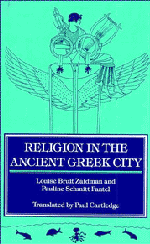Book contents
- Frontmatter
- Contents
- List of illustrations
- Author's preface to the English translation
- Translator's introduction
- List of sources
- PART I Introduction: How should we study Greek civic religion?
- PART II Cult-practices
- 4 Rituals
- 5 Religious personnel
- 6 Places of cult
- 7 Rites of passage
- 8 Settings of religious life
- 9 Religion and political life
- 10 The festival system: the Athenian case
- 11 The Panhellenic cults
- PART III Systems for representing the divine
- PART IV Envoi
- Appendixes
- Bibliography
- Index
11 - The Panhellenic cults
Published online by Cambridge University Press: 05 June 2012
- Frontmatter
- Contents
- List of illustrations
- Author's preface to the English translation
- Translator's introduction
- List of sources
- PART I Introduction: How should we study Greek civic religion?
- PART II Cult-practices
- 4 Rituals
- 5 Religious personnel
- 6 Places of cult
- 7 Rites of passage
- 8 Settings of religious life
- 9 Religion and political life
- 10 The festival system: the Athenian case
- 11 The Panhellenic cults
- PART III Systems for representing the divine
- PART IV Envoi
- Appendixes
- Bibliography
- Index
Summary
GENERAL FEATURES
So far in this book the emphasis has been placed squarely upon the tight nexus between religious and civic life, as we have been attempting to show how all citizens were enmeshed in the network of festivals and rituals through which they were integrated into the civic community. But the emergence of the city as a state-form and way of life was also contemporary with a truly original and highly consequential religious phenomenon, namely the appearance and development in several parts of Greece of interstate sanctuaries – sanctuaries, that is, whose influence and catchment-area exceeded the limits of the individual city. These served as places of meeting and exchange for Greeks coming from the farthest reaches of the Hellenic world. It was no coincidence that in this same epoch, the second half of the eighth century, the first wave of overseas migration from the Greek heartland began, chiefly to Magna Graecia (south Italy) and Sicily.
In ‘Old Greece’ there was now a sharp increase in archaeological sites yielding votive deposits of valuable objects – painted pottery and terracotta figurines to begin with, then objects of bronze, jewellery, and finally arms and armour. The surplus wealth that had formerly been reserved for destruction in aristocratic burials was now being diverted to the greater glory of the gods, especially those of Olympia, Delphi, Dodona and Delos, all sites which were destined to experience a Panhellenic florescence.
- Type
- Chapter
- Information
- Religion in the Ancient Greek City , pp. 112 - 140Publisher: Cambridge University PressPrint publication year: 1992

